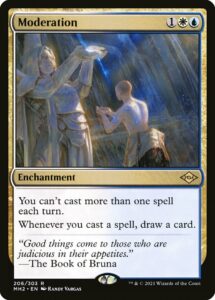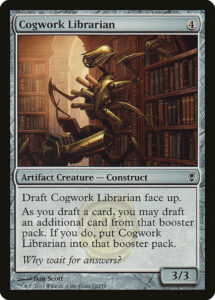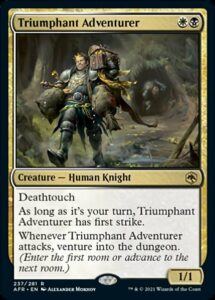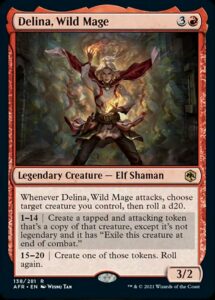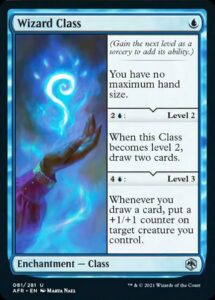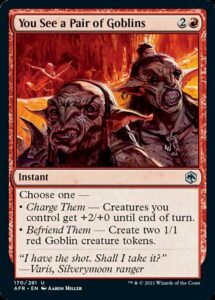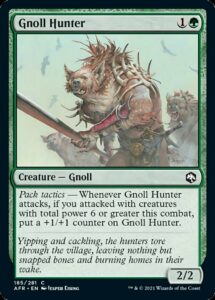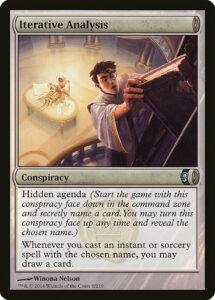We’re well into the first week of Dungeons & Dragons: Adventures in the Forgotten Realms Limited. It’s the longest name of any Magic set ever, and it’s quite unlike the usual fare of summer Core Sets. AFR has a lot going on and had less time than ever to pore over the spoilers—just one day between the end of previews and the format’s availability online (and two days before Commander spoilers began). But despite the short time frame, Magic Arena makes it easy to draft quickly. I’ve got about fifteen drafts and a few traditional 3-0s under my belt (and a slew of 2-1s), so there’s a fair bit to discuss.
Moderating Complexity
The first thing which stood out to me is AFR’s approach to complexity. So much of its design works to keep complexity in check to counterbalance its massive possibility space. While no creatures are actual vanillas, most have one triggered ability upon entering the battlefield, dying, attacking, or dealing combat damage to a player—this helps prevent a creature’s text box from complicating combat math on the fly.
It’s a necessary boon, since between all of the modal “You Encounter A Thing” spells providing two disparate effects, creatures with similar abilities having differing rewards (the UB archetype is saboteur abilities but all of them are different), the d20 effects having a range of 2-3 similar-but-still-distinct bonuses, and the incredible variety of Venturing rewards; there’s just so many more things that could happen in a game of AFR than in almost any other set.
Despite being the summer release, Adventures in the Forgotten Realms is absolutely not a Core Set. It’s very much a product that benefits from Arena ensuring that all abilities trigger properly and all rules are followed. You can give Deathtouch creatures Trample. You need to stack Reaper’s Talisman and Spare Dagger‘s triggers correctly if you want to build your own Doom Blade. You are constantly presented with choices like when to sacrifice your Treasure or save it, which dungeon to commit to Venturing through, and whether you can afford to have a d20 roll not go your way. There is a lot for a Spike to appreciate and many ways for a game to go astray.
The Mechanics
Another way that AFR isn’t a Core Set is its array of new mechanics: Venture + Dungeons, rolling d20, Class enchantments, flavor words, and Pack Tactics.
Venture we took a few stabs at last week. Having played with it a fair amount, it feels fun but weak. It’s cool in that it allows a variety of inputs to combine and output a variety of bonuses (like Energy). Yet the variance of those bonuses makes them weaker than if you could just consistently Scry 1 or create a Treasure. The time delay and uncertainty between each Venture further dilutes the rewards.
I’ve almost never Ventured into the Dungeon of the Mad Mage because of how long it takes to be better than the Lost Mine of Phandelver (or just going through the Lost Mine twice). I appreciate all the thought that went into these designs—each Dungeon needs to be a viable option without being cognitively overwhelming while also telling a story—but I’ve mostly lost enthusiasm for Venturing. It feels like a lot of work for fairly minimal rewards. As someone who enjoys grinding value, I’m surprised that I don’t like Venture more; but it feels like building a mediocre, inconsistent Saga rather than something powerful and feels nothing like roleplaying through a dungeon.
As with Venture, rolling d20 is another hard mechanic for Wizards to nail. It has to be powerful enough to be a centerpiece of Limited, but weak enough that it doesn’t show up in the Spikey Constructed formats. Most of the designs follow an excellent convention: a 45% chance of something good, a 50% chance of a better version, and a 5% chance of an amazing version. This mirrors the feel-good of rolling a natural 20, avoids the feel-bad of rolling a natural 1, and makes it so you can always know what’s going to happen (unless you’re playing with Power of Persuasion, which seems like it was designed to be looked at rather than played with).
I expected to dislike rolling d20s, since it embraces high variance while Unstable’s die rolling was restrained, but the 45-50-5 convention really works for me. Frankly, my biggest complaint is that the blue-red d20 mechanic doesn’t seem to have enough support. Sure, I’ve had some strong turns with Pixie Guide and died to the frustrating Delina, Wild Mage Splinter Twin combo which needed to be patched on day 1, but there just aren’t enough ways to reliably roll d20s to go off with Feywild Trickster.
Class enchantments are a very cool iteration of the Level Up mechanic. I simply adore them. I’ve always loved build-around uncommon enchantments and providing multiple cycles of them (some of which are unsurprisingly much better than others) gives the format depth. Just watch out for all the ways to incidentally disrupt enchantments.
Flavor words are a new innovation, where single-use keywords connect a D&D concept to a mechanical Magic effect. I enjoy these much more on the “You Encounter A Thing” spells where they pull more weight rather than on creatures where they sometimes add text to just one ability. That said, I could see Magic employing these again even on new planes—adding some flavor justification could help players grok walls of text like the Strixhaven Deans.
Pack Tactics is a new ability word, like Ferocious, Formidable, Raid, and Battalion, mechanics which it descends from. It took some time to recognize that it as a separate mechanic and from the set’s many flavor words, but I really like it. It plays differently from its forebears (especially the oft-used and rarely-keyworded Ferocious), enables different kinds of designs (namely a lot more on-attack triggers), and is much easier to achieve than Ferocious and Formidable. I’d be happy to see it added to Magic’s rotating stable of staple aggressive mechanics.
Overall, I’m pleased with the mechanics and innovation in AFR. Yes, Venture and rolling d20—the two big mechanics—have shortcomings, but both had strong reasons to not be pushed for Constructed. Not to mention that in the year following Adventures, Escape, and Companions, Play Design had good reason not to heavily push mechanics built around randomness and accumulating slow, incremental advantages.
I was worried that Adventures in the Forgotten Realms would be designed primarily to attract D&D players to Magic (or vice versa) rather than be something non-D&D players would love. Having played with it, I do think that increasing Wizards’ audiences is a primary goal, but that’s a fine goal and I do enjoy AFR much more than the usual summer Core Set. It’s not the kind of set I’m eager to play competitively because of the die rolling and sheer amount of text, choices, and triggers on cards, but it’s nevertheless something I’m happy playing and expect to play more of than the usual Core Set.
I do wish it had come out a bit later so I’d have more time with Modern Horizons 2, but we’ve had overstuffed summers for five years now. Here’s hoping that next year there’ll be a bit more time for supplemental sets to breathe and it’ll be safe enough for big, in-person tournaments.
Zachary Barash is a New York City-based game designer and the commissioner of Team Draft League. He designs for Kingdom Death: Monster, has a Game Design MFA from the NYU Game Center, and does freelance game design. When the stars align, he streams Magic (but the stars align way less often than he’d like).

